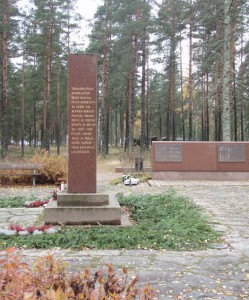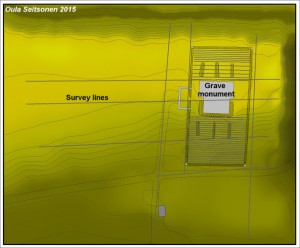Oula Seitsonen took part last week in geoarchaeological surveys of Finnish Civil War (1918) mass grave sites with the Finnish Association for Forensic Archaeology and Anthropology (FAFAA). Forensic archaeology applies archaeological research methods in the forensic and crime scene studies.
FAFAA field studies aim at comparing and developing advantageous non-invasive survey methods for working with the contemporary (and historical) mass grave sites and other burials. FAFAA co-operates with the Lapland’s Dark Heritage project, and archaeo-geophysical surveys of for example World War 2 plane crash sites and mass graves in Lapland have been planned.
Ground penetrating radar at the Tammisaari mass grave monument (Photograph: Oula Seitsonen).
Finnish Civil War mass graves have been studied by FAFAA, in co-operation with the Department of Geography and Geosciences, University of Helsinki, and the Finnish Defense Forces, with ground penetrating radar and other archaeo-geophysical methods at Tammisaari and Santahamina; studies at Tammisaari have been financially supported by the Kansan sivistysrahasto Tammisaari 1918 trust.
Mass graves at both Tammisaari and Santahamina derive from the Prisoner-of-War camps established by the victorious White side for the defeated Reds in 1918: Whites and their German allies captured tens of thousands of Red Guard members and associated people, including several thousand women and over 1000 children. Living conditions at the PoW camps were poor, and at the worst camp, Tammisaari, mortality rate exceeded 30 percent. Altogether ca. 1 percent of the country’s population was annihilated by the Civil War: only half in the battlefields and the rest by executions, disease and famine. This left the newly independent state severely divided for decades after the Civil War.
General map of the Tammisaari mass grave site showing the survey lines (© Oula Seitsonen).
More about the Finnish Civil War:
Haapala, P. & Hoppu, T. (toim. ) 2009: Sisällissodan pikkujättiläinen. WSOY.
Upton, A.F. 1980: The Finnish Revolution 1917-1918. University of Minnesota Press.
Finnish Civil War archaeology:
Seitsonen, O. & Kunnas, L. 2009: Ahvola 1918: Archaeological Reconnaissance of a Finnish Civil War Battlefield. Journal of Conflict Archaeology 5.
Lagerstedt, J. 2008: Ensimmäisen maailmansodan maalinnoitteet Suomessa. Sotilaskäytöstä suojelukohteiksi. MA thesis, Department of Archaeology, University of Helsinki.
Harju, S. 2006: Sisällissodan jäljet — Sota-arkeologinen tutkimus Tampereen puolustuksesta vuonna 1918. BA thesis, Department of Archaeology, University of Helsinki.



